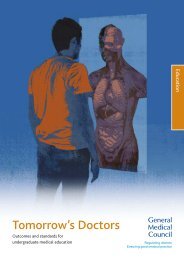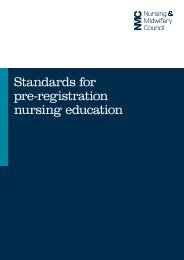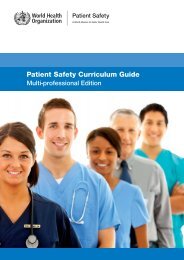7. Triangulat<strong>in</strong>g the evidence basePressure to assemble evidence to support claims made for IPE had built up dur<strong>in</strong>gthe late 1990s at a time of mount<strong>in</strong>g concern to establish the evidence-base, notonly for professional practice, but also for professional education (Hargreaves,1996). The first of five <strong>in</strong>ternational conferences entitled All Together Better Healthheld <strong>in</strong> 1997 seemed an ideal opportunity to focus on the effectiveness of<strong>in</strong>terprofessional practice <strong>and</strong> IPE as a means to promote it.Two propositions were put: that IPE improves collaborative practice that <strong>in</strong>terprofessional practice improves the quality of <strong>care</strong>Dist<strong>in</strong>guished scholars were <strong>in</strong>vited from both sides of the Atlantic to address thesepropositions (Leathard, 1997). Outcomes fell short of expectations which, withbenefit of h<strong>in</strong>dsight, were naïve although some progress was made <strong>in</strong> refram<strong>in</strong>gquestions <strong>and</strong> mapp<strong>in</strong>g territory. The answers, it became pa<strong>in</strong>fully clear, were go<strong>in</strong>gto be more complex than the propositions. There would be no „quick fix‟.Most UK IPE <strong>in</strong>itiatives had reportedly been evaluated (Barr & Waterton, 1996), butdocumentation was sparse <strong>and</strong> publications lack<strong>in</strong>g, while a few rigorouslyconducted evaluations were cited repeatedly. Overviews of IPE developments wereillum<strong>in</strong>at<strong>in</strong>g, but <strong>in</strong>variably stopped short of provid<strong>in</strong>g examples that might haveaugmented the small pool of published evaluations.Track<strong>in</strong>g down isolated evaluations was not enough. Susta<strong>in</strong>ed <strong>and</strong> systematicsearches were needed to collate evaluations that would provide a basel<strong>in</strong>e for futurepolicy, po<strong>in</strong>ters for future evaluations <strong>and</strong> verify or vitiate claims made for IPE.Systematic reviews were beg<strong>in</strong>n<strong>in</strong>g <strong>in</strong> <strong>health</strong><strong>care</strong> practice, notably under theauspices of the Cochrane Collaboration. These developments prompted UKresearchers to explore the application of that methodology to determ<strong>in</strong>e the efficacyof IPE. An approach to Cochrane elicited an encourag<strong>in</strong>g response <strong>and</strong> a reviewgroup was established under its Effective Practice <strong>and</strong> Organisation of Care Group(EPOC) with Merrick Zwarenste<strong>in</strong> (then with the South African Medical ResearchCouncil) as mentor. Criteria for the review that followed focused narrowly on directbenefit to patients attributable to an IPE <strong>in</strong>tervention evaluated by a r<strong>and</strong>omizedcontrolled trial, a controlled before <strong>and</strong> after study, or an <strong>in</strong>terrupted time seriesstudy. None were found despite an exhaustive search of over a thous<strong>and</strong> abstractsfrom electronic databases <strong>and</strong> scrut<strong>in</strong>y of 89 papers (Zwarenste<strong>in</strong>, Reeves, Barr,Hammick, Koppel & Atk<strong>in</strong>s, 2001). The group faced a choice, either to ab<strong>and</strong>on itssearch or to renew it after an <strong>in</strong>terval <strong>in</strong> accordance with its obligation to theCochrane Collaboration. In the event, the review was updated follow<strong>in</strong>g Cochranepractice, search<strong>in</strong>g the same <strong>and</strong> additional sources from 1999 to 2006. Six studieswere found which met the same <strong>in</strong>clusion criteria as before. Four out of the sixreported a range of positive outcomes (Reeves, Zwarenste<strong>in</strong>, Goldman, Barr, Freeth,Hammick & Koppel, 2008).Whilst the group was will<strong>in</strong>g to honour Cochrane‟s expectation to update its review,most members felt crimped <strong>and</strong> cramped by its l<strong>in</strong>ear <strong>and</strong> positivist approach. Theirown research had heightened their awareness of alternative paradigms – qualitative34
as well as quantitative – for the evaluation of education. They determ<strong>in</strong>ed to conducta further systematic review tak<strong>in</strong>g <strong>in</strong>to account a cont<strong>in</strong>uum of outcomes <strong>and</strong> arange of research methodologies. The group was reconstituted as the<strong>Interprofessional</strong> <strong>Education</strong> Jo<strong>in</strong>t Evaluation Team (JET), with some changes ofmembership, <strong>and</strong> a new review undertaken.Its report (Barr, Koppel, Reeves, Hammick & Freeth, 2005) was built around the 107robust evaluations found, which met quality checks for presentation <strong>and</strong> rigour. Athird of the studies came from the UK <strong>and</strong> over half from the United States with therema<strong>in</strong>der widely spread. Evenly divided between community <strong>and</strong> hospital based<strong>care</strong>, two thirds related to chronic conditions. Four fifths were post qualification <strong>and</strong>typically work-based workshops. Almost all had been published s<strong>in</strong>ce 1991.Reported outcomes were classified <strong>and</strong> collated as follows (with multiple cod<strong>in</strong>g): reactions to the <strong>in</strong>terprofessional learn<strong>in</strong>g 45 (42%) changes <strong>in</strong> attitudes/perceptions 21 (20%) acquisition of knowledge/skills 38 (36%) changes <strong>in</strong> behaviour 21 (20%) changes <strong>in</strong> organisational practice 37 (35%) benefit to patients 20 (19%)The first three outcomes spanned pre- <strong>and</strong> post-registration IPE; the last threereferred <strong>in</strong>variably to work-based cont<strong>in</strong>u<strong>in</strong>g <strong>in</strong>terprofessional education whereservice improvement was an explicit objective.The <strong>in</strong>ference was clear, albeit derived from only a few studies. Pre-registration IPEcould lay foundations for collaborative practice <strong>in</strong> attitud<strong>in</strong>al change <strong>and</strong> enhancedknowledge <strong>and</strong> skills; work-based post-registration IPE was needed to build onthose foundations before impact on practice <strong>and</strong> patient <strong>care</strong> would be apparent. Atissue was whether subsequent pre-registration IPE <strong>in</strong>terventions would develop thecapacity to meet the higher order outcomes or whether the constra<strong>in</strong>ts, e.g. theimmaturity of the student group, would render such expectations unrealistic.A follow up study (Hammick, Freeth, Koppel, Reeves & Barr, 2007) imposed ahigher threshold <strong>and</strong> analysed data from 21 of the studies by precept, process <strong>and</strong>product of educational delivery (Biggs, 1993; Dunk<strong>in</strong> & Biddle, 1974). F<strong>in</strong>d<strong>in</strong>gsconfirmed that IPE was generally well received, enabl<strong>in</strong>g knowledge <strong>and</strong> skillsnecessary for collaborative practice to be learnt.Along the way, the same group conducted a UK review under the auspices ofCAIPE <strong>and</strong> funded by the British <strong>Education</strong>al Research Association (Barr, Freeth,Hammick, Koppel & Reeves, 2000). Less systematic than the three reviewsreported above, it benefited from the team‟s <strong>in</strong>timate knowledge of IPE <strong>in</strong>itiatives <strong>in</strong>the UK. The outcome was the presentation of 19 qualitative case studies with acommentary. The earliest of these cases dated back to the 1970s. Evaluations hadbeen conducted mostly by the teachers with uneven rigour, limited impact <strong>and</strong>without reference to other such evaluations. There were, however, signs that thesedefects were be<strong>in</strong>g remedied. More evaluations were be<strong>in</strong>g conducted <strong>in</strong> the UK,more often published, with more cross-communication <strong>and</strong> more rigorousmethodology. Ongo<strong>in</strong>g monitor<strong>in</strong>g by JET confirmed that the number of robust35
- Page 4: ForewordsThis report is an importan
- Page 7: PrefaceThe turn of the Century was
- Page 13 and 14: 2. Promoting Interprofessional Educ
- Page 15: capabilities were published. The Sh
- Page 18: develop sustainable abilities appro
- Page 21 and 22: 4. Developing teaching and learning
- Page 23 and 24: Students were expected to achieve t
- Page 25 and 26: Assessing learningIt became clear o
- Page 27 and 28: Assessment and Learning in Practice
- Page 29 and 30: different professions at Coventry U
- Page 31 and 32: show how students created new inter
- Page 33 and 34: The allied health professionsStanda
- Page 35: Information for prospective student
- Page 39 and 40: “Interprofessional learning/educa
- Page 41 and 42: CAIPE convened two-day „split‟
- Page 43 and 44: 9. Taking stockThe widespread suppo
- Page 45 and 46: References:Anderson, E.S, Cox, D. &
- Page 50 and 51: Interprofessional Education Collabo
- Page 52 and 53: Pearson, P., Ashcroft, D., and Buck
- Page 54 and 55: determinants of population health V
- Page 56 and 57: B. A bibliographyBooks and papers f
- Page 58: Wilcock, P., Campion-Smith, C. & El













